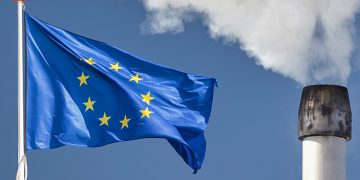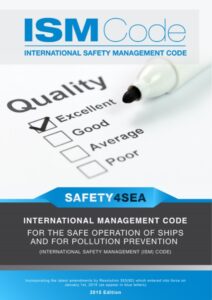The purpose of the International Safety Management (ISM) Code is to provide an international standard for the safe management and operation of ships and for pollution prevention. The Code’s origins go back to the late 1980s, when there was mounting concern about poor management standards in shipping.
Read in this series
- ISM Code: Latest Updates
- ISM Code: How to handle Non-Conformities
- ISM Code: What to include in Master’s SMS Review
The catastrophic capsizing of the passenger/car ferry Herald of Free Enterprise in March 1987 as well as investigations into several accidents revealed major errors on the part of management. Thus, in 1987 the IMO Assembly adopted resolution A.596(15), which called upon the Maritime Safety Committee to develop guidelines concerning shipboard and shore‑based management to ensure the safe operation of ro-ro passenger ferries.
[smlsubform prepend=”GET THE SAFETY4SEA IN YOUR INBOX!” showname=false emailtxt=”” emailholder=”Enter your email address” showsubmit=true submittxt=”Submit” jsthanks=false thankyou=”Thank you for subscribing to our mailing list”]
The ISM Code has been the most controversial among all shipping legislative documents. After 20 years of implementation, the industry still examines the effectiveness of the Code, as there are plenty of seafarers and shore staff who feel that ISM Code has only brought more paper work to daily operations. However, the general idea and the objective of the Code is to enhance safety culture based on a documented and assessed operation environment in which each one has a specific role and responsibility (both ashore and on board personnel).
The Code defines that ‘Company’ holds the responsibility to take over all duties imposed by the Code, incorporating SMS into normal business operations. It also requires internal & external audits, certificates, a Designated person who will be a link between ship and shore and clarifies levels of authority and lines of communications. These are also accompanied with checklists, related forms and procedures.
ISM Code Amendments: Timeline
- 1 July 2002: The ISM Code was initially amended by Resolution 104(73), adding definitions and chapter 13 to 16.
- 1 July 2006: The ISM Code was further amended by Resolution 179(79), inserting new sections to the forms of the DOC (Document of Compliance) and SMC (Safety Management Certificate).
- 1 January 2009: The ISM Code was amended by Resolution 195(80) , adding text to the forms of the full term and interim DOC and the SMC Certificates.
- 1 July 2010: ISM Code Resolution 273(85) entered into force, introducing among others amended definitions, addition of cross references, risk requirements, specific intervals for implementation and SMS review effectiveness criteria.
- 1 January 2015: The latest amendments by Resolution 353(92) entered into force, updating and crosslinking the existing IMO documents
Recognizing that no two shipping companies of shipowners are the same, and that ships operate under a wide range of different conditions, the Code is based on general principles and objectives, including Part A (Implementation) and Part B (Certification and Verification).
As the Code states ”The cornerstone of good safety management is commitment from the top. In matters of safety and pollution prevention it is the commitment, competence, attitudes and motivation of individuals at all levels that determines the end result”
Contents of Part A
- General
- Definitions
- Objectives
- Application
- Functional requirements for a Safety Management Systems (SMS)
- Safety and environmental protection policy.
- Company responsibilities and authority.
- Designated person(s)
- Master’s responsibility and authority
- Resources and personnel.
- Development of plans for shipboard operations.
- Emergency preparedness
- Reports and analysis of non-conformities, accidents and hazardous occurrences
- Maintenance of the ship and equipment.
- Documentation
- Company verification, review and evaluation
Contents of Part B
- Certification, and periodical Verification
- Interim Certification
- Verification
- Forms of Certificates
The Code is expressed in broad terms so that it can have a widespread application. Clearly, different levels of management, whether shore-based or at sea, will require varying levels of knowledge and awareness of the items outlined.
PART A
1.General
1.1 Definitions under the ISM Code
The following definitions apply to parts A and B of this Code
- International Safety Management (ISM) Code : the International Management Code for the Safe Operation of Ships and for Pollution Prevention as adopted by the Assembly, as may be amended by the Organization.
- Company: the Owner of the ship or any other organization or person such as the Manager, or the Bare boat Charterer, who has assumed the responsibility for operation of the ship from the Shipowner and who on assuming such responsibility has agreed to take over all the duties and responsibility imposed by the Code.
- Administration: the Government of the States whose flag the ship is entitled to fly.
- Safety Management System: means a structured and documented system enabling Company personnel to implement effectively the Company Safety and Environmental protection policy.
- Document of Compliance: a document issued to a Company which complies with the requirements of this Code.
- Safety Management Certificate: a document issued to a ship which signifies that the Company and its shipboard management operate in accordance with the approved safety management system.
- Objective Evidence: quantitative or qualitative information, records or statements or fact pertaining to safety or to the existence and implementation of a safety management system element, which is based on observation, measurement or test and which can be verified.
- Observation : a statement of fact made during a safety management audit and substantiated by objective evidence
- Non Conformity: an observed situation where objective evidence indicates the non-fulfillment of a specified requirement
- Major non-conformity: an identifiable deviation that poses a serious threat to the safety of personnel or the ship or a serious risk to the environment that requires immediate corrective action or the lack of effective and systematic implementation of this Code*.
*Refer to the Procedures concerning observed ISM Code major non-conformities (MSC/Circ.1059-MEPC/Circ.401).
- Anniversary date: the day and month of each year that corresponds to the date of expiry of the relevant document or certificate.
- Convention: the International Convention for the Safety of Life at Sea, 1974 as amended.
1.2 Objectives of the ISM Code
1.2.1 The objectives of the Code are to ensure safety at sea, prevention of human injury or loss of life, and avoidance of damage to the environment, in particular, to the marine environment, and to property.
1.2.2 Safety management objectives of the Company should, inter alia:
- provide for safe practices in ship operation and a safe working environment,
- assess all identified risks to its ships, personnel and the environment and establish appropriate safeguards; and
- continuously improve safety management skills of personnel ashore and aboard ships, including preparing for emergencies related both to safety and environmental protection.
1.2.3 The safety management system should ensure:
- compliance with mandatory rules and regulations, and
- that applicable codes, guidelines and standards recommended by the Organization, Administrations, classification societies and maritime industry organizations are taken into account*
* Refer to the List of codes, recommendations, guidelines and other safety and security related non-mandatory instruments (MSC.1/Circ.1371).
1.3 Application
The requirements of this Code may be applied to all ships.
1.4 Functional Requirements for a Safety Management System (SMS)
Every Company should develop, implement and maintain a Safety Management System (SMS) which includes the following functional requirements:
- a safety and environmental protection policy,
- instructions and procedures to ensure safe operation of ships and protection of the environment in compliance with relevant international and flag State legislation,
- defined levels of authority and lines of communication between, and amongst, shore and shipboard personnel,
- procedures for reporting accidents and non-conformities with the provisions of this Code,
- procedures to prepare for and respond to emergency situations, and
- procedures for internal audits and management reviews.
2. Safety and Environmental Protection Policy
2.1 The Company should establish a safety and environmental protection policy which describes how the objectives, given in paragraph 1.2, will be achieved.
2.2 The Company should ensure that the policy is implemented and maintained at all levels of the organization both ships based as well as shore based.
3. Company Responsibilities and Authority
3.1 If the entity who is responsible for the operation of the ship is other than the owner, the owner must report the full name and details of such entity to the Administration.
3.2 The Company should define and document the responsibility, authority and interrelation of all personnel who manage, perform and verify work relating to and affecting safety and pollution prevention.
3.3 The Company is responsible for ensuring that adequate resources and shore based support are provided to enable the designated person or persons to carry out their functions.
*Refer to the Guidelines for the operational implementation of the International Safety Management (ISM) Code by Companies (MSC-MEPC.7/Circ.5).”
4. Designated Person (s)*
To ensure the safe operation of each ship and to provide a link between the company and those on board, every company, as appropriate, should designate a person or persons, ashore having direct access to the highest level of management. The responsibility and authority of the designated person or persons should include monitoring the safety and pollution prevention aspects of the operation of each ship and to ensure that adequate resources and shore based support are applied, as required.
* Refer to the Guidance on the qualifications, training and experience necessary for undertaking the role of the Designated Person under the provisions of the International Safety Management (ISM) Code (MSC-MEPC.7/Circ.6).
5. Mater’s Responsibility and Authority
5.1 The Company should clearly define and document the master’s responsibility with regard to:
.1 implementing the safety and environmental protection policy of the Company,
.2 motivating the crew in the observation of that policy,
.3 issuing appropriate orders and instructions in a clear and simple manner,
.4 verifying that specified requirements are observed, and
.5 reviewing the SMS and reporting its deficiencies to the shore based management periodically.
5.2 The Company should ensure that the SMS operating on board the ship contains a clear statement emphasizing the Master’s authority. The Company should establish in the SMS that the master has the overriding authority and the responsibility to make decisions with respect to safety and pollution prevention and to request the Company’s assistance as may be necessary.
6. Resources and Personnel
6.1 The Company should ensure that the master is:
.1 properly qualified for command,
.2 fully conversant with the Company’s SMS, and
.3 given the necessary support so that the Master’s duties can be safely performed.
6.2 The Company should ensure that each ship is:
.1 manned with qualified, certificated and medically fit seafarers in accordance with national and international requirements; and
.2 appropriately manned in order to encompass all aspects of maintaining safe operations on board*.
* Refer to the Principles of minimum safe manning, adopted by the Organization by resolution A.1047(27).
6.3 The Company should establish procedures to ensure that new personnel and personnel transferred to new assignments related to safety and protection of the environment are given proper familiarization with their duties. Instructions which are essential to be provided prior to sailing should be identified, documented and given.
6.4 The Company should ensure that all personnel involved in the Company’s SMS have an adequate understanding or relevant rules, regulations, codes and guidelines.
6.5 The Company should establish and maintain procedures for identifying any training which may be required in support of the SMS and ensure that such training is provided for all personnel concerned.
6.6 The Company should establish procedures by which the ship’s personnel receive relevant information on the SMS in a working language or languages understood by them.
6.7 The Company should ensure that the ship’s personnel are able to communicate effectively in the execution of their duties related to the SMS.
7. Development of Plans for Shipboard Operations
The Company should establish procedures, plans and instructions, including checklists as appropriate, for key shipboard operations concerning the safety of the personnel, ship and protection of the environment. The various tasks should be defined and assigned to qualified personnel.
8. Emergency Preparedness*
8.1 The Company should identify potential emergency shipboard situations and establish procedures to respond to them.
8.2 The Company should establish programs for drills and exercises to prepare for emergency actions.
8.3 The SMS should provide for measures ensuring that the Company’s organization can respond at any time to hazards, accidents and emergency situations involving its ships.
*Refer to the Guidelines for a structure of an integrated system of contingency planning for shipboard emergencies, adopted by the Organization by resolution A.852(20), as amended.
9. Reports and Analysis of Non- Conformities, Accidents and Hazardous Occurrences*
9.1 The SMS should include procedures ensuring that non-conformities, accidents and hazardous situations are reported to the Company, investigated and analyzed with the objective of improving safety and pollution prevention.
9.2 The Company should establish procedures for the implementation of corrective action, including measures intended to prevent recurrence.
* Refer to the Guidance on near-miss reporting (MSC-MEPC.7/Circ.7).
10. Maintenance of the Ship and Equipment
10.1 The Company should establish procedures to ensure that the ship is maintained in conformity with the provisions of the relevant rules and regulations and with any additional requirements which may be established by the Company.
10.2 In meeting these requirements the Company should ensure that:
.1 inspections are held at appropriate intervals,
.2 any non-conformity is reported with its possible cause, if known,
.3 appropriate corrective action is taken, and
.4 records of these activities are maintained.
10.3 The Company should identify equipment and technical systems the sudden operational failure of which may result in hazardous situations. The SMS should provide for specific measures aimed at promoting the reliability of such equipment of systems. These measures should include the regular testing of stand-by arrangements and equipment or technical systems that are not in continuous use.
10.4 The inspections mentioned in 10.2 as well as the measures referred to 10.3 should be integrated in the ship’s operational maintenance routine.
11. Documentation*
11.1 The Company should establish and maintain procedures to control all documents and data which are relevant to the SMS.
11.2 The Company should ensure that:
.1 valid documents are available at all relevant locations,
.2 changes to documents are reviewed and approved by authorized personnel, and
.3 obsolete documents are promptly removed.
11.3 The documents used to describe and implement the SMS may be referred to as the “Safety Management Manual” Documentation should be kept in a form that the Company considers most effective. Each ship should carry on board all documentation relevant to that ship.
*Refer to the Revised list of certificates and documents required to be carried on board ships (FAL.2/Circ.127, MEPC.1/Circ.817 and MSC.1/Circ.1462).
12. Company Verification, Review and Evaluation
12.1 The Company should carry out internal safety audits on board and ashore at intervals not exceeding twelve months to verify whether safety and pollution prevention activities comply with the SMS. In exceptional circumstances, this interval may be exceeded by not more than three months.
12.2 The Company should periodically verify whether all those undertaking delegated ISM related tasks are acting in conformity with the Company’s responsibilities under the Code
12.3 The Company should periodically evaluate the effectiveness of the SMS in accordance with procedures established by the Company.
12.4 The audits and possible corrective actions should be carried out in accordance with documented procedures.
12.5 Personnel carrying out audits should be independent of the areas being audited unless this is impracticable due to the size and the nature of the Company.
12.6 The results of the audits and reviews should be brought to the attention of all personnel having responsibility in the area involved.
12.7 The management personnel responsible for the area involved should take timely corrective action on deficiencies found.
Explore more by reading the ISM Code (2015 version) herebelow:
































































What are the role of Second engineer as per ISM?
Nothing. The Code does not specify. Chief Engineer be assigned all the tasks in the SMS, but that SMS would be questioned when reviewed, but that is another matter.
Assist the C/E to make sure all equipment onboard ready be use during emergency and make sure PMS be check n verify accordingly.
Where was overriding authority mentioned prior ism era
How we come to know it is implemented on ship
How ism implemented right?
Safety familiarisation given prior joining ship
Risk assessment carried out
Safety and environmental protection policy display
Records of checklist
Records of drills
Records of maintenance carried out
Records of defect list
Records of internal/ external audits
Display of DPA name and number.
Records of near miss reported.etc etc
What are the different shipboard operations that are being ruled out by ISM Code?